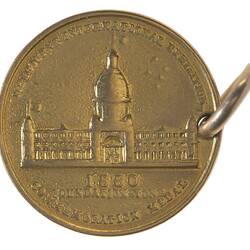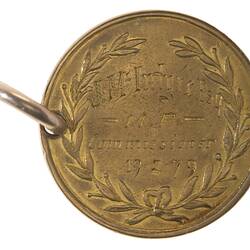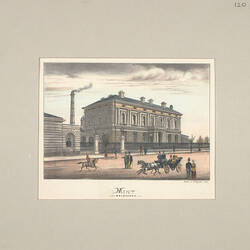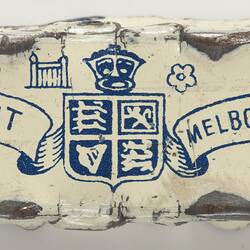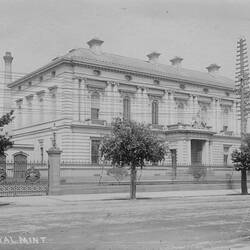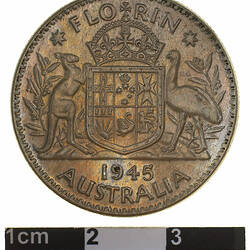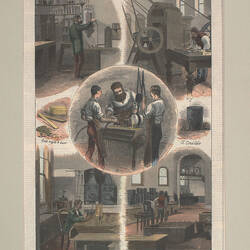Summary
Australia Victoria Melbourne
Melbourne International Exhibition Foundation Stone Medal 1880 (AD)
Mint: Melbourne
Awarded to: McIntyre, John (Sir)
Other Details: This gold medal was issued to commemorate the laying of the Foundation Stone for the Melbourne Exhibition Building. It was given to John McIntyre, businessman and politician, who had lost the seat of Sandhurst just before the Exhibition. McIntyre had represented Victoria at the 1876 Philadelphia Centennial Exhibition, partly to observe arrangements in order to assist Victoria to plan its own centennial celebrations. In 1880 and 1888 he was an ex-officio Commissioner for Melbourne's international exhibitions. Gold medals were distributed in February 1879, manufactured by the Melbourne Mint. The Mint also prepared two silver and ond bronze pieces for its own collection. The Melbourne International Exhibition ran from 1 October 1880 to 30 April 1881. The exhibition building that still stands was constructed for the occasion, designed by Joseph Reed and built by David Mitchell. Over 1.3 million people visited the exhibition at a time when Melbourne's population was only around 282,000.
Physical Description
A gold medal holed at obv. 09 with gold loop (worn as a fob-piece) it features a front view of the proposed Exhibition Building with the Southern Cross in the sky above right. The reverse gives the name J. McIntyre M.P., a Commissioner, and the date 19.2.79
Obverse Description
Melbourne exhibition buildings with Southern Cross in sky to right; above, MELBOURNE INTERNATIONAL EXHIBITION, below, 1880/FOUNDATION STONE/COMMEMORATION MEDAL
Reverse Description
Within an olive wreath engraved: J. McIntyre M.P. Commissioner 19.2.79
Edge Description
Plain
Significance
The Melbourne International Exhibition Foundation Stone medal was issued in a remarkably short time. On 13 February 1879 the medal was suggested to a meeting of the Executive Commissioners of the 1880 Melbourne International Exhibition. Members would receive medals in time to wear them in their button holes at the laying of the foundation stone of the Exhibition Buildings, a mere six days later. The seemingly impossible task was given to Mr Were, one of the Commissioners. Were went straight to the Melbourne Mint the instant the meeting closed and left a note suggesting that the design picture the building, the name of the Commissioner, the date, the southern cross and further ornamentation.
The Mint leapt into action, undaunted by their lack of a die engraver. A pair of old soverign dies were selected and softened, and their design removed. Ernst Altmann, a Melbourne die cutter and jeweller, was pressed into service by Deputy Master of the Mint, V. Delves Broughton. Two days later Altmann wrote to the Mint advising that he was unhappy with the balance of the design they had suggested. The exhibition building appeared to be floating in space, and Altmann suggested that the words 'FOUNDATION STONE' and 'COMMEMORATION MEDAL' be added underneath. The changes were made, and the next morning Altmann handed over the dies. He waited while they were hardened, rushed them back to his workshop to polish them, and had them back to the Mint by noon. A total of 70 gold medals were struck that afternoon, as well as six silver pieces for the stone-laying ceremony. A further two silver pieces and one copper piece were struck, now in the Museum Victoria collection. The obverse die cracked under the strain. The medals were ready in time for the ceremony.
Later, in June that year, the Commissioners ordered additional medals, and Altmass cut a second obverse die. 36 medals were struck. A year later a further 53 medals were struck. -Sharples, John. 1985. The 1880 Melbourne International Exhibition Foundation Stone Medal. -D. Tout-Smith 13/10/2003.
More Information
-
Collecting Areas
-
Acquisition Information
Cultural Gifts Donation from Mr J W. McIntyre, 26 Feb 1990
-
Acknowledgement
Donated through the Australian Government's Cultural Gifts Program.
-
Date Issued
1880 AD
-
Issued By
-
Mint
Melbourne Branch of Royal Mint, Melbourne, Greater Melbourne, Victoria, Australia, 1879
-
Artist
Ernst August Altmann, Melbourne, Greater Melbourne, Victoria, Australia, 1879
-
Awarded To
Sir John McIntyre - M.L.A., Melbourne, Greater Melbourne, Victoria, Australia, 1879
-
Inscriptions
Obverse: MELBOURNE INTERNATIONAL EXHIBITION / FOUNDATION STONE / COMMEMORATION MEDAL Reverse engraved: J. McIntyre M.P. Commissioner 19.2.79
-
Series
-
Material
Gold
-
Axis
12
-
Classification
Medals, Commemorative, Melbourne international exhibition 1880-1881
-
Category
-
Discipline
-
Type of item
-
Dimensions
22 mm (Outside Diameter), 8.17 (Weight)
Width with loop extended 27 mm
-
Shape
Round
-
References
[Article] Sharples, John. 1985. The 1880 Melbourne International Exhibition Foundation Stone Medal.
[Book] 1882. Official Record of the Melbourne International Exhibition 1880-1881.
-
Keywords

